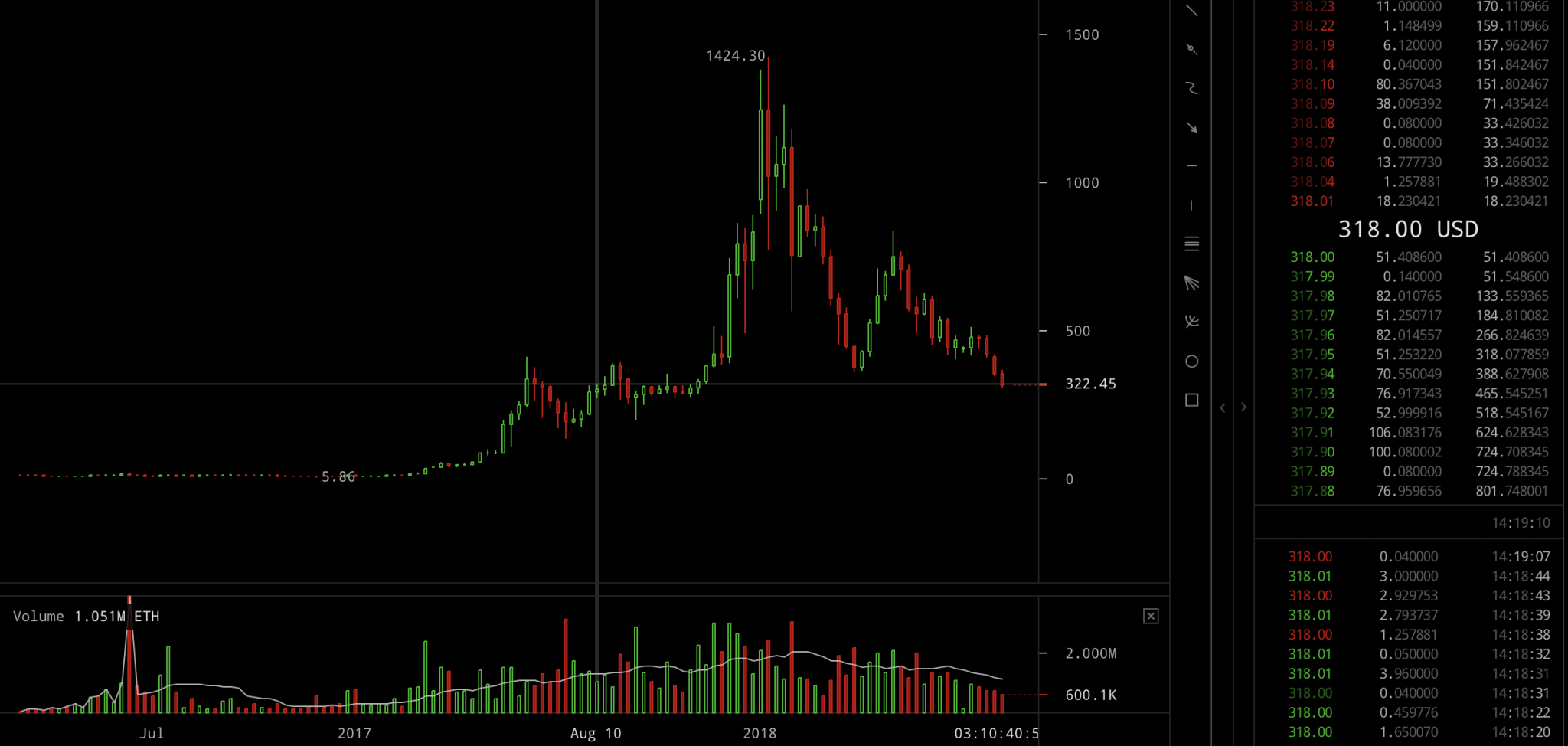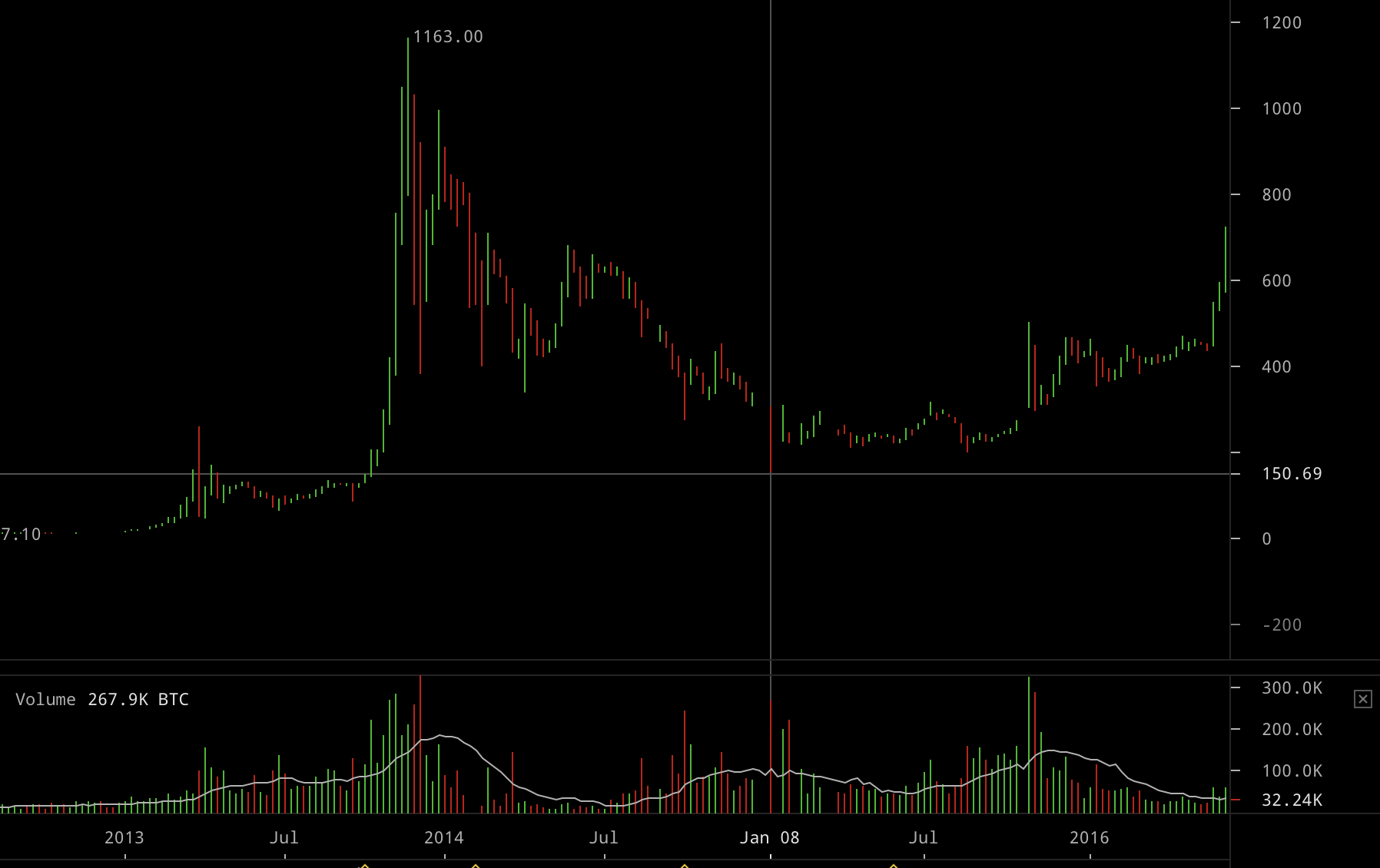Ethereum’s Price is Now Lower Than a Year Ago in an Echo of Bitcoin 2015

For the first time since ethereum’s invention three years ago, its price has fallen below what it was precisely one year ago.
On August 10th 2017, ethereum’s price stood at $322. Today, its current price is at $318 at the time of writing.

The only time this has occurred previously, for a major coin, is in bitcoin during 2015 after the MT Gox black-swan bankruptcy.
This time, however, there has been no major black swan event to fuel a bear market. It appears instead much of its continuation is a sentimental game of chairs.

We know how the story developed for bitcoin, but for eth it is yet to be told. One sticking similarity, however, among many, is how what appears to be one of their main selling point can also turn into a double edged sword.
Bitcoin found adoption in commerce in 2014, with numerous household brands starting to accept it for payments. Yet as the bear market dragged on, some bitcoiners started turning against it.
Back then as now most merchants instantly converted their bitcoins into fiat. That put some pressure on bitcoin’s price. The narrative thus slowly started to change with bitcoin then becoming a store of value.
It is of course still accepted for payments with BitPay stating they process a bitcoin payment every ten seconds, but that’s no longer the focus for btc.
For eth too a number of household brands, as well as many other projects, have ICO-ed. Yet as the bear market drags on, some are turning against them.
As with merchants, most ICOs need to convert to fiat to cover expenses or fund their project, so exerting pressure on eth’s price.
The general sentiment is still positive towards ICOs, as it remained positive towards merchants in bitcoin, but there’s a lot to be learned.
No start-up, for example, needs $4 billion as was the case with EOS. They hardly need half a million really or one million if they do not have a working product. Further ICOs can then be had depending on their progress.
That, of course, was the original idea. To have a smart contract that controls the funds with token holders then voting on how much of it they should release.
That idea was and remains radical and even revolutionary, grabbing imagination in many ways, but the Slockit DAO was hacked, with the idea then kind of shelved for now.
It reminds one very much of the MT Gox hack in 2011 which then led to a general thinking that digital money as a concept was flawed because your money can be stolen.
With the DAO, too, it was shelved because smart contracts can be hacked. Yet generalizing from one event doesn’t sound very smart. The experiment should be tried again, with a cap of $20 million or so. Then ICOs can be exciting again.
Obviously the sell pressure would remain, but that can be cancelled and more where there are returns on it through innovative projects and so on.
That’s because the criticisms appear to be less addressed at the sell pressure and more towards misallocation of funds due to potentially misaligned incentives, leading to undue sell pressure without sufficient return to counterbalance it or even to provide added benefits in addition.
The risk here is that the ecosystem goes back to gatekeeping VCs or even to complying with discriminatory regulations which deny very many fine men and women the opportunity to participate in value creation unless they are very rich.
When a balance can be found by retaining the best parts while minimizing the more negative aspects by establishing a self-regulatory organization that lays out common sense rules based on what has been learned so far.
The lesson for bitcoin back then was to create a cycle where an employee paid in bitcoin can spend it on merchants who then pay suppliers in bitcoin with the suppliers then paying their employees and other merchants in btc.
That’s, however, far more easily said than done partly due to considerable price volatility with it being a bit of a chicken and egg question.
While for ICOs, the problem seems to be a lot more easy. You just lay down some rules, try to get a regulator on board, have some way of potentially fining non-complying ICOs or somehow punishing them, and you’re done.
But that too is more easily said than done because a regulator and some of the ecosystem has to stand up and establish such organization, with them failing to do so far.
All of this echo does suggest that this appears to be cyclical and part of how crypto adoption grows with errors becoming self evident in addition to adoption at times getting ahead of what the ecosystem can handle.
And then a quieter period follows during which the infrastructure matures and grows with the ecosystem becoming ready to learn new lessons, of which undoubtedly there will be many.
Copyrights Trustnodes.com














Article comments